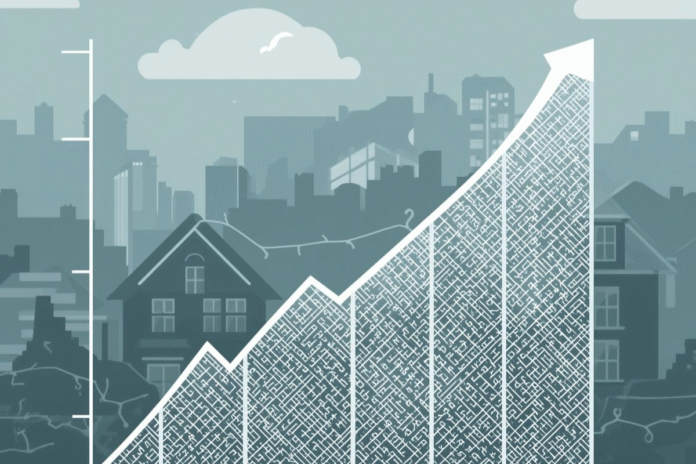Private rents are continuing to rise at nearly double the pace of house prices according to new official figures that highlight the intensifying affordability squeeze on households across the UK.
Average monthly rents climbed 5.5% in the year to September, reaching a record £1,354, the Office for National Statistics said.
Although the rate of growth has eased slightly from 5.7% a month earlier, rent inflation remains far above income growth and continues to outstrip wider consumer inflation.
England remains the most expensive part of the country for tenants, with average rents rising 5.5% to £1,410.
REGIONAL OUTLOOK
Wales and Northern Ireland saw the fastest increases – both up 7.1% – with the average tenancy now costing £815 in Wales and £865 in Northern Ireland. Scottish rents rose more slowly, up 3.4% to £1,004.
The regional picture in England shows widening divergence. The North East recorded the sharpest annual increase at 9.1 per cent, driven by strong demand and limited supply, while Yorkshire and The Humber saw the weakest rise at 3.8%.
Several major English cities continue to report double-digit rent growth, adding pressure on younger households and private renters already facing elevated living costs.
HOUSE PRICE GROWTH COOLING
While the rental market heats up, house price growth is cooling. The UK House Price Index shows average property values rising just 3% in the year to August, reaching £273,000 – a slight slowdown from the 3.2% annual rate recorded in July.
England remains the most expensive market, with house prices up 2.9% to £296,000. Wales saw weaker growth at 2% to £211,000, while Scotland recorded the strongest rise at 4% to £194,000.
Rents are rising at almost twice the pace of house prices, reversing the pattern seen through much of the last decade and fuelling concerns about the long-term health of the private rented sector.
Analysts say the imbalance reflects constrained supply, higher landlord costs and a surge in demand from would-be buyers delayed by mortgage affordability challenges.
AFFORDABILITY PRESSURES

Richard Donnell, Executive Director of Research at Zoopla, said: “The last house price index data shows a slowdown in house price and rental inflation as affordability pressures bite.
“This slowdown is expected to continue into 2026. More first tome buyers and lower migration for work and study is easing the pressure on rents, with rents for new lets rising at their lowest level for four years.
“Pre-Budget jitters are hitting housing market activity.”
“Pre-Budget jitters are hitting housing market activity at the start of the home buying process. Demand and sales agreed for homes priced over £500,000 are down by up to 9% on this time last year as buyers pause home buying decisions.
“There are 350,000 homes where the sale has been agreed moving towards completion and some buyers of expensive homes will be nervous about possible changes to council tax for their new purchases.
“All eyes are now on next week’s Budget – if the housing market gets off lightly then we expect a rebound in demand and activity, but if the impact on consumer confidence is greater, then we could have a sluggish start to 2026.”
MORE OPTIONS

Lee Williams, national sales manager at Saffron for Intermediaries, added: “Today’s figures highlight the housing market’s continued resilience amid ongoing political uncertainty.
“Despite this environment, the market has shown steady growth. This resilience, along with a recent increase in activity, has boosted buyer confidence and led to a wider range of mortgage options.”
TAKING TIME

Gareth Lewis, deputy CEO of specialist lender MT Finance, said: “Property prices may have stagnated slightly but there are still people trying to buy.
“One of the challenges they are facing is that it is taking forever for a transaction to go through – whether that is down to lack of commitment or with the budget round the corner, it is hard to tell.
“The key point is that there is a crying need for stimulus in the property market so that it will start functioning properly. Interest rates have come down and settled and mortgage rates are probably where they need to be, but still there is nothing to encourage first-time buyers to get on the ladder or second-steppers and beyond to move up it.
“Properties are on the market for extended periods of time and even if values were to decrease to make them more affordable, it is unlikely to be enough.
“We need a real call to action.”
“We need a real call to action. Stamp duty is the biggest expense for most when moving house and reducing or reforming this would create an energy and buzz, saving people money and result in them wanting to transact.
“The Government should think of it this way: the more people who transact, the more stamp duty it will generate and the more it will drive revenue for the Treasury.”
“There are still deals to be had.”

Chris Storey, Chief Commercial Officer at Atom bank, added: “While the ONS has reported a slowing in the rate of house price growth, they have still hit another record high.
“Despite this, there are deals to be had – analysis from Propertymark shows that 93% of sales at the moment are at below asking price, the highest ratio in years.
“While prices are rising, vendors are willing to negotiate, and the falls in mortgage rates mean buyers feel more comfortable pursuing a transaction.
“Next week’s Budget has to be seen as a great opportunity to boost the position of hopeful buyers.
“Despite promises of greatly improved rates of housebuilding, production is going backwards, and until that challenge is tackled we are likely to see house prices grow further.
“While measures that support high-LTV buyers would be welcome, the Chancellor must ensure they don’t simply push prices to unaffordable levels.”





